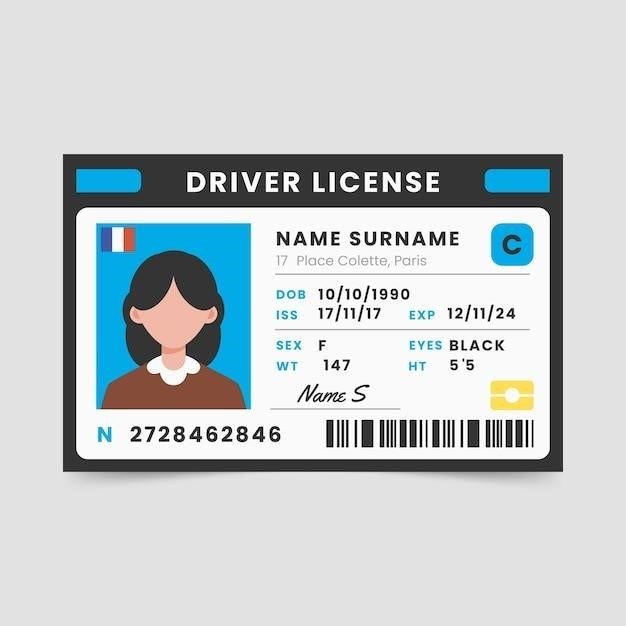texas drivers license template pdf
A Texas Drivers License Template PDF is a digital file that allows you to create a mock driver’s license for various purposes․ These templates are often used for novelty, educational, or personal use․ You can customize the template with your own information, including your name, address, photo, and license number․ Remember that these templates are not legally valid and should not be used to deceive or impersonate others․
What is a Texas Drivers License Template PDF?
A Texas Drivers License Template PDF is a digital file that provides a visual representation of a Texas driver’s license, allowing users to customize it with their own information․ These templates are not official documents issued by the Texas Department of Public Safety (DPS) and are not legally valid for identification or driving purposes․ They are often used for novelty purposes, such as creating fun party invitations, prank cards, or even pet ID cards․ Some people use these templates for educational purposes, like learning graphic design or understanding the layout and elements of a driver’s license․ It’s crucial to remember that using these templates for any illegal or deceptive activities, such as impersonating someone else or creating counterfeit documents, is strictly prohibited and could have serious legal consequences․ The Texas Drivers License Template PDF serves as a visual aid for creative projects and should not be mistaken for an official document․

How to Edit a Texas Drivers License Template
Editing a Texas Drivers License Template is a straightforward process that can be completed using various graphic design software, such as Adobe Photoshop․ The template typically comes as a PSD (Photoshop Document) file, which allows you to modify individual layers․ To begin, open the template in Photoshop and navigate through the different layers, each representing a specific element of the license․ You can easily change the text fields by double-clicking on them and typing in your desired information, such as your name, address, date of birth, license number, and expiration date․ The template usually includes a placeholder for a photo; you can insert your own image by dragging it into the designated area․ Some templates also allow you to customize the barcode and signature․ Remember that while you can edit the template to your liking, it is crucial to use it responsibly and ethically․ Avoid using the edited template for any illegal or deceptive activities․
Types of Texas Drivers License Templates
Texas Drivers License Templates are available in a variety of formats and designs, each catering to specific purposes․ Some templates are designed for novelty use, offering a playful and creative way to create mock licenses for parties, events, or personal amusement․ Others are intended for educational purposes, providing a visual representation of a driver’s license for learning or training purposes․ There are also templates designed for personal use, allowing individuals to create custom licenses for identification purposes within specific contexts, such as school events or club memberships․ Additionally, commercial use templates might be available for businesses or organizations that require mock licenses for promotional materials or marketing campaigns․ Finally, templates for government use might be found, but these are typically restricted and require specific authorization․ It is crucial to understand the intended use of each template and ensure its application aligns with relevant laws and regulations․
Where to Find Texas Drivers License Templates
Finding Texas Drivers License Templates is relatively straightforward․ Numerous online platforms offer a wide selection of these templates, catering to various needs․ Popular stock photo and design websites often feature downloadable templates in various formats, including PSD (Photoshop) and PDF․ You can also explore specialized websites dedicated to providing printable templates, which often offer free or paid options․ Additionally, online marketplaces and digital asset stores may house a collection of Texas Drivers License Templates, allowing you to browse and choose the most suitable option for your specific purpose․ Remember to check the terms of use and licensing agreements associated with each template before downloading and using it․ Always prioritize reputable sources and ensure the template aligns with your intended use, whether for novelty, educational, or personal purposes․
Using Texas Drivers License Templates for Legal Purposes
It’s crucial to understand that using Texas Drivers License Templates for legal purposes is strictly prohibited and can have serious consequences․ These templates are not official documents and do not carry the legal weight of an authentic driver’s license issued by the Texas Department of Public Safety․ Using a template for any purpose that could be construed as illegal or fraudulent is a serious offense and could result in legal action, including fines, imprisonment, or a criminal record․ Texas law requires specific documentation and procedures for obtaining a valid driver’s license, and attempting to circumvent these regulations using a template is illegal․ If you need a valid driver’s license, the only acceptable method is to apply through the official channels outlined by the Texas Department of Public Safety․
Texas Drivers License Template for Novelty Use
Texas Drivers License Templates are often used for novelty purposes, such as creating funny or creative props for parties, events, or personal projects․ For example, you might use a template to create a fake ID for a costume party or to make a humorous “pet license” for your furry friend․ These templates are designed to look like real driver’s licenses but lack the legal authority and security features of genuine documents․ They are purely for entertainment and should not be used for any purpose that could be mistaken for a real driver’s license․ When using a Texas Drivers License Template for novelty purposes, it’s essential to be clear about its intended use and avoid any actions that could be misconstrued as deception or fraud․
Texas Drivers License Template for Educational Purposes
Texas Drivers License Templates can serve educational purposes, particularly in classrooms or workshops where students are learning about graphic design, document creation, or security features․ These templates can help students understand the layout and design elements of a driver’s license, as well as the importance of security features that prevent forgery․ Educators can use these templates to demonstrate how to create and edit digital documents, including adding images, text, and other elements․ By working with these templates, students can gain practical experience in digital design and learn about the potential uses and misuses of digital documents․ It’s important to emphasize that these templates are for educational purposes only and should not be used to create or distribute fake or unauthorized documents․
Texas Drivers License Template for Personal Use
Texas Drivers License Templates can be used for personal projects, especially for creative and artistic endeavors․ You might use a template to create a unique and personalized ID card for a costume party, a fun gift for a friend, or a humorous birthday card․ These templates can also be used for scrapbooking or creating photo albums to add a touch of realism or humor to your projects․ The possibilities are endless, as long as you use the template responsibly and ethically․ Remember that these templates are not intended for any illegal or fraudulent activities, and it’s crucial to avoid any actions that might cause harm or confusion․ Always be mindful of the potential consequences of using these templates for personal projects, and ensure your intentions are clear and harmless․
Texas Drivers License Template for Commercial Use
While Texas Drivers License Templates can be used for various purposes, commercial use is a different matter altogether․ It’s important to understand that using these templates for commercial gain is highly discouraged and potentially illegal․ Creating fake driver’s licenses for commercial purposes, such as selling them as novelty items or using them for promotional purposes, is a serious offense․ The law strictly prohibits the distribution or sale of fake identification documents, even for entertainment or promotional purposes․ If you are considering using a Texas Drivers License Template for any business-related activities, it’s crucial to consult with legal professionals to ensure compliance with all relevant regulations and avoid potential legal repercussions․ Remember that respecting the law and ethical standards is crucial when using these templates, and any commercial use should be carefully considered and reviewed․
Texas Drivers License Template for Government Use
The use of Texas Drivers License Templates for government purposes is strictly prohibited․ Government agencies, including the Texas Department of Public Safety (DPS), have specific security protocols and regulations in place to ensure the authenticity and security of official driver’s licenses․ Using unofficial templates for government functions could compromise data security, lead to identity theft, and create legal complications․ Any attempts to create or use fake licenses for government purposes, such as obtaining services or accessing restricted areas, are illegal and could result in serious consequences․ It’s essential to remember that government-issued identification documents are crucial for verifying identity and ensuring the integrity of various processes․ Using unofficial templates for these purposes is unethical and illegal and should be avoided at all costs․ If you require a Texas Drivers License for any official government purpose, it’s essential to contact the Texas Department of Public Safety directly for the correct procedures and documentation․
Texas Drivers License Template FAQs
Here are some frequently asked questions about Texas Drivers License Templates⁚
- Are Texas Drivers License Templates legal? While creating a template itself might not be illegal, using it to create a fake ID is․ It’s crucial to use these templates responsibly and for non-deceptive purposes․
- Can I use a Texas Drivers License Template for my child’s birthday party? Yes, these templates are often used for fun, creative projects, and novelty purposes․ It’s important to make it clear that the license is not real and is just for entertainment․
- Where can I find a Texas Drivers License Template? You can often find free templates online through websites like Freepik, Printablee, or by searching for “Texas Drivers License Template PDF” on Google․
- Is it legal to create a fake Texas Drivers License? No, creating a fake ID or using a template to impersonate someone else is illegal and can lead to serious consequences․ It’s important to use these templates responsibly and for legal purposes․
Remember, using Texas Drivers License Templates for any illegal activities is strictly prohibited․ It’s essential to use them responsibly and for legitimate purposes․


